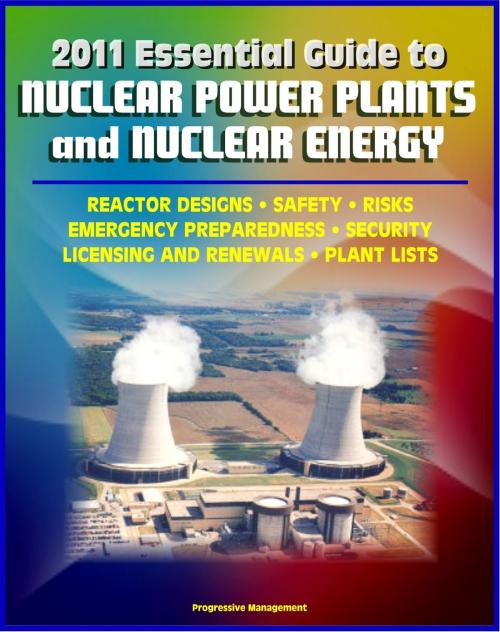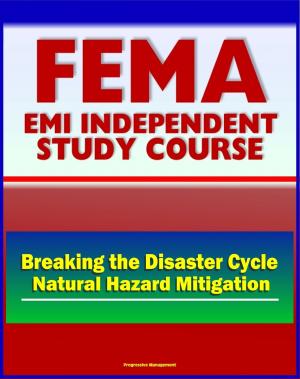2011 Essential Guide to Nuclear Power Plants and Nuclear Energy: Reactor Designs, Safety, Emergency Preparedness, Security, Renewals, New Designs, Licensing, American Plants, Decommissioning
Nonfiction, Science & Nature, Science, Physics, General Physics, Social & Cultural Studies, Political Science| Author: | Progressive Management | ISBN: | 9781458113696 |
| Publisher: | Progressive Management | Publication: | March 13, 2011 |
| Imprint: | Smashwords Edition | Language: | English |
| Author: | Progressive Management |
| ISBN: | 9781458113696 |
| Publisher: | Progressive Management |
| Publication: | March 13, 2011 |
| Imprint: | Smashwords Edition |
| Language: | English |
This authoritative guide provides up-to-date, official information on nuclear power plants and the nuclear energy industry with coverage of commercial reactor designs, safety, emergency preparedness, security, renewals, new designs, licensing, American plants, decommissioning, soviet plants, fuel cycle, and more. Contents include: Pressurized Water Reactors (PWRs) * Boiling Water Reactors (BWRs) * Reactors by Region in the U.S. * March 2011 * List of Power Reactor Units * New Nuclear Plant Designs * Emergency Preparedness at Nuclear Power Plants * Emergency Planning Zones * Emergency Classification * Terrorism and Emergency Preparedness * Oversight of Nuclear Power Plants * Inspection Program * Nuclear Reactor Risk * Policy, Regulations, and Regulatory Framework * Seismic Issues for Existing Nuclear Power Plants * Environmental Monitoring * Underground Pipes at Nuclear Reactors * Reactor License Renewal * Nuclear Security * Security Inspections and Rulemaking * Force-on-Force Security Inspections * Nuclear Power for Electrical Generation Reactor Concepts Manual * Reactor Fuel Assemblies * High Temperature Gas-Cooled Reactor (HTGR) * Outlook for New U.S. Reactors * Current Status of U.S. Nuclear Industry * Federal Initiatives To Encourage New Nuclear Power Plant Construction * Nuclear Power in the U.S. – An Overview * Nuclear Power and the Environment * The Nuclear Fuel Cycle * U.S. Nuclear Power History * TVA’s Nuclear at a Glance * Soviet Nuclear Power Plant Designs * International Nuclear Event Scale * Nuclear Power Options Viability Study * Advanced Nuclear Energy * Decommissioning Nuclear Power Plants * Demolition of a Reactor Containment Building * Decommissioning Status for Shut Down NRC-Licensed Power Reactors * Frequently Asked Questions About License Applications for New Nuclear Power Reactors.
In the U.S., 104 commercial nuclear power reactors are licensed to operate at 65 sites in 31 States. For each site, there are onsite and offsite emergency plans to assure that adequate protective measures can be taken to protect the public in the event of a radiological emergency. Federal oversight of emergency preparedness for licensed nuclear power plants is shared by the NRC and Federal Emergency Management Agency (FEMA). This sharing is facilitated through a Memorandum of Understanding (MOU). The MOU is responsive to the President's decision of December 7, 1979, that FEMA take the lead in overseeing offsite planning and response, and that NRC assist FEMA in carrying out this role. The NRC has statutory responsibility for the radiological health and safety of the public by overseeing onsite preparedness and has overall authority for both onsite and offsite emergency preparedness. For planning purposes, the NRC defines two emergency planning zones (EPZs) around each nuclear power plant. The exact size and configuration of the zones vary from plant to plant due to local emergency response needs and capabilities, population, land characteristics, access routes, and jurisdictional boundaries. The two types of EPZs are:
The plume exposure pathway EPZ extends about 10 miles in radius around a plant. Its primary concern is the exposure of the public to, and the inhalation of, airborne radioactive contamination.
This is a privately authored news service and educational publication of Progressive Management.
This authoritative guide provides up-to-date, official information on nuclear power plants and the nuclear energy industry with coverage of commercial reactor designs, safety, emergency preparedness, security, renewals, new designs, licensing, American plants, decommissioning, soviet plants, fuel cycle, and more. Contents include: Pressurized Water Reactors (PWRs) * Boiling Water Reactors (BWRs) * Reactors by Region in the U.S. * March 2011 * List of Power Reactor Units * New Nuclear Plant Designs * Emergency Preparedness at Nuclear Power Plants * Emergency Planning Zones * Emergency Classification * Terrorism and Emergency Preparedness * Oversight of Nuclear Power Plants * Inspection Program * Nuclear Reactor Risk * Policy, Regulations, and Regulatory Framework * Seismic Issues for Existing Nuclear Power Plants * Environmental Monitoring * Underground Pipes at Nuclear Reactors * Reactor License Renewal * Nuclear Security * Security Inspections and Rulemaking * Force-on-Force Security Inspections * Nuclear Power for Electrical Generation Reactor Concepts Manual * Reactor Fuel Assemblies * High Temperature Gas-Cooled Reactor (HTGR) * Outlook for New U.S. Reactors * Current Status of U.S. Nuclear Industry * Federal Initiatives To Encourage New Nuclear Power Plant Construction * Nuclear Power in the U.S. – An Overview * Nuclear Power and the Environment * The Nuclear Fuel Cycle * U.S. Nuclear Power History * TVA’s Nuclear at a Glance * Soviet Nuclear Power Plant Designs * International Nuclear Event Scale * Nuclear Power Options Viability Study * Advanced Nuclear Energy * Decommissioning Nuclear Power Plants * Demolition of a Reactor Containment Building * Decommissioning Status for Shut Down NRC-Licensed Power Reactors * Frequently Asked Questions About License Applications for New Nuclear Power Reactors.
In the U.S., 104 commercial nuclear power reactors are licensed to operate at 65 sites in 31 States. For each site, there are onsite and offsite emergency plans to assure that adequate protective measures can be taken to protect the public in the event of a radiological emergency. Federal oversight of emergency preparedness for licensed nuclear power plants is shared by the NRC and Federal Emergency Management Agency (FEMA). This sharing is facilitated through a Memorandum of Understanding (MOU). The MOU is responsive to the President's decision of December 7, 1979, that FEMA take the lead in overseeing offsite planning and response, and that NRC assist FEMA in carrying out this role. The NRC has statutory responsibility for the radiological health and safety of the public by overseeing onsite preparedness and has overall authority for both onsite and offsite emergency preparedness. For planning purposes, the NRC defines two emergency planning zones (EPZs) around each nuclear power plant. The exact size and configuration of the zones vary from plant to plant due to local emergency response needs and capabilities, population, land characteristics, access routes, and jurisdictional boundaries. The two types of EPZs are:
The plume exposure pathway EPZ extends about 10 miles in radius around a plant. Its primary concern is the exposure of the public to, and the inhalation of, airborne radioactive contamination.
This is a privately authored news service and educational publication of Progressive Management.















